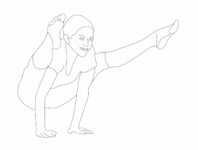What is the meaning of the headstand yoga pose?
Headstand yoga pose or Sirsasana, sometimes also known as yoga headstand pose, is the only pose that stimulates all body organs. This upside-down yoga is known for its numerous health benefits. That’s why the great yoga teacher BKS Iyengar named the headstand pose “King of all asanas”. In the modern lifestyle, most people hardly do any physical exercise and sit in one position for protracted lengths of time. Vigorous and regular exercise speeds up blood circulation and ensures that the brain receives sufficient well-oxygenated blood. The lack of exercise, characteristic of modern city-dwelling men, leads to obesity, diabetes, hair problems, skin issues, and general inefficiency of the body’s organs. But, a Yoga headstand is, in a sense, an unnatural method of combating a supernatural lifestyle. Besides, Sirsasana is an excellent yoga pose to enhance skin glow, strengthen the hair follicles, panacea for brain health and good for weight loss, among other essential benefits.

Do you know how to do a Yoga headstand pose step by step?
Simple and easy headstand steps are described here. If you want to learn upside-down yoga poses, those who are beginners should follow the steps minutely.
- First of all, make a cup by interlocking your fingers.
- The top of the head should be placed in the cup by kneeling or doing a pose, just like Parvatasana.
- Try to bring your toes towards your head by raising your knees above the ground.
- Now, slowly, slowly raise your legs upward. One can take the help of a wall or person to raise the legs upward.
- If you can raise your legs straight up, focus entirely on your balance.
- After making your body upside down straight, try to relax the whole body, especially the muscles, and breathe slowly and deeply.
- Now, slowly fold your legs and bring them to the floor.
- As far as maintaining the pose is concerned, one should hold it as per one’s capacity or maximum up to 5 minutes. But the beginner initially should hold only for a few seconds.
Yoga headstand poses health benefits
- Hair loss is a pretty common phenomenon these days. The cosmetic industry is garnering massive profits in the name of hair loss medicines and products. But, such medication also comes with many side effects. The primary reason for the greying of hair and hair loss is the lesser circulation of oxygenated blood in the scalp and hair follicle region. The practice of tripod headstand yoga can be essential as it bathes the scalp cells and tissues with oxygenated blood and nourishes it.
- pimples, wrinkles, acne, and blemishes can be prevented and treated more significantly by regular tripod yoga. Due to the method of Sirsasana, fresh blood loaded with nutrients moves to the facial region and rejuvenates the cells of this area, thereby ensuring a fair skin complexion. The tripod yoga pose is also beneficial to remove the waste toxins from these regions of the body.
- The tripod stand yoga pose largely controlled the pituitary and thyroid glands. Since the thyroid gland releases thyroxin, which is responsible for the body’s metabolic process, it helps regulate weight.
- A tripod headstand is the best yoga pose for the brain’s overall health. Inversion yoga helps make pure and fresh blood available to the brain cells. The entire brain and all the billions of cells here receive more nourishment due to the practice of this yoga pose. All the cells are getting fresh and rejuvenated blood, ensuring higher productivity in their work mechanism.
- Headache and migraine are believed to be partly caused by compression of certain blood vessels in the brain. The forearm headstand helps to relax and strengthen these vessels, thereby preventing these ailments.
- The increased blood flow to the brain revitalises various nervous centres and the controller of the endocrinal system, the pituitary. In this way, tripod headstand yoga helps rectify multiple glandular and nervous disorders. The yoga headstand acts like a panacea for preventing and managing diabetes. Salamba Sirshasana, however, acts directly on the pituitary gland by improving the blood supply, and this is a great help in combating diabetes.
- Headstand pose has also been a great help in combating sexual disorders such as prostate problems, hydrocele, leucorrhea, spermatorrhea and all general menopausal and menstrual ailments.
- Various ailments such as myopia, astigmatism, catarrh and general bad hearing have been improved by regular practice of Yoga headstands.
- Two prevalent ailments are varicose veins and piles (haemorrhoids) caused by the accumulation of blood in the legs and anus, respectively. In stagnated life, it is generally seen that blood accumulates in the legs and in the pelvic and abdominal organs. This drainage removes impure stagnant blood to replace it with pure, oxygenated blood after performing the headstand.
A scientific explanation of upside-down yoga
Many studies have been conducted to measure the changes within the body while practising tripod yoga poses. X-rays taken during the headstand practice have shown a considerable shift of the diaphragm, changes in the longitudinal and transverse dimensions of the heart, and widening of the arteries and veins leading to and from the lungs, especially in the upper lobes that leads to more oxygenation of lungs.
Practising the headstand pose ensures oxygen consumption by the tissues increases, and the amount of oxygen exhaled is reduced, indicating that oxygen transfer to the blood is significantly increased. It also helps increase the white blood cell count, implying that the body’s ability to withstand and resist infection increases.
Yoga Inversion for Beginners
- For beginners, the headstand is not as easy as it seems.
- Initially, they should do yoga inversion chair or the headstand chair.
- To learn to do a headstand, beginners should use a supported headstand, yoga headstand chair, wall headstand, or, better do, with Ardha Sirsasana.
- Doing a headstand with blocks or a hollow back headstand is also suitable for beginners.
- There shouldn’t be movement in the head or arms while performing the pose to skip imbalance.
- Try to keep the whole body vertical in the final pose; don’t incline it backwards, forwards or sideways.
- While attaining the final position, the focus should be on relaxation.
- In the final stage, toes shouldn’t be pointed outward; keep them relaxed for better blood drainage from the legs.
- Weight of body weight should be on the head rather than the arms.
Supported headstand breathing and duration
- In the initial stage, breathe in.
- Hold the breath inside while raising the body to the final pose.
- Breathe slowly and deeply in the final position.
- Breathe deeply and then hold your breath as you lower the body to the starting position.
- The person practising Sirsasana for a more extended period can practise for up to thirty minutes.
- But, it shouldn’t be done by beginners shouldn’t do beginners as it could cause more harm than good.
- Beginners should start with no more than thirty seconds, and the duration can gradually increase with practice.
- If you feel the slightest fatigue, trembling, head strain or general anxiety, stop doing the asana.
Sirsasana counterpose
- Tadasana
- Shavasana
- Stickasana
- Kneeling position for about thirty seconds with the head on the ground.
Sirsasana headstand sequence
- If somebody practises only asanas without pranayama and meditation, then practise sirshasana at the beginning of the program.
- If your practice program includes pranayama and meditative practices, you should do sirshasana immediately after the other asanas.
- Beginners should generally do the practice after other asanas.
Tripod headstand yoga contraindications
In the following conditions, headstand yoga shouldn’t be performed.
- High blood pressure
- Weak heart
- Coronary thrombosis
- Arteriosclerosis
- Weak eye blood vessels
- Conjunctivitis and chronic glaucoma
- Any form of bleeding in the head
- Otia (inflammation of the ears)
- Chronic catarrh
- Slipped disc
- Extremely impure blood, since the impurities could be directed into the brain
- Kidney problems
- During pregnancy or menstruation.
Beginner yoga headstand pose advice
- Sirsasana pose shouldn’t be practised If your bowels are full.
- If you are physically tired, skip practising the pose.
- In case of headache or migraine, one shouldn’t practice it because these conditions may aggravate.
- It should be practised after passing 30 minutes of intense physical exercise.
- In case of headache, suffocation, dizziness, sweating profusely, or heart palpitations, it shouldn’t be practised.
- There is no such age bar in performing the yoga pose; however, older adults should practice it carefully.
Types of Headstand Yoga Poses
- Headstand Yoga pose
- Bound hands headstand
- Bound angle pose in headstand
- Headstand backbend
- Single-leg headstand
- Free hands headstand
- Single leg revolved headstand
- Side headstand
- Single-leg headstand
- Seated angle pose in headstand
- Upward lotus in headstand







1 thought on “9 Yoga Headstand Pose Benefits For Weight Loss, Skin, Hair”